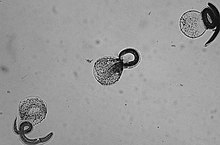Baylisascaris
| Baylisascaris | |
|---|---|

| |
| Baylisascaris procyonis larvae | |
| Scientific classification | |
| Domain: | Eukaryota |
| Kingdom: | Animalia |
| Phylum: | Nematoda |
| Class: | Chromadorea |
| Order: | Ascaridida |
| Family: | Ascarididae |
| Genus: | Baylisascaris Sprent, 1968[1] |
Baylisascaris is a genus of roundworms that infect more than fifty animal species.[citation needed]
Life cycle
Baylisascaris eggs are passed in feces and become active within a month. They can remain viable in the environment for years, withstanding heat and cold.[2] Animals become infested either by swallowing the eggs or eating another animal infested with Baylisascaris.[2]
Disease progression
After an animal swallows the eggs, the microscopic
Clinical signs in humans
Are the following:[citation needed]
- Skin irritations from larvae migrating within the skin.
- Respiratory discomfort, liver enlargement, and fever due to reaction to larvae migration.
- Eye and brain tissue damage due to the random migration of the larvae.
- Nausea, a lethargic feeling, incoordination and loss of eyesight.
- Severe neurological signs including imbalance, circling and abnormal behavior, caused by extensive tissue damage due to larval migration through the brain, eventually seizures and coma.
Treatment
While deworming can rid the intestine of adult Baylisascaris, no treatment has been shown to alleviate illness caused by migrating larvae.[3] Despite lack of larvicidal effects, albendazole (20–40 mg/kg/d for 1–4 weeks) has been used to treat many cases.[4]
Baylisascaris species
Each Baylisascaris species has a host species that it uses to reproduce. The eggs appear in the host species' feces. They can then be ingested by, and infest, a variety of other animals (including humans) that serve as paratenic hosts.[citation needed]
Baylisascaris species include:
- Baylisascaris procyonis (of raccoons)[5]
- Baylisascaris melis (of European badgers)
- Baylisascaris transfuga (of bears)
- Baylisascaris columnaris (of skunks and American badgers)
- Baylisascaris devosi (of fishers and martens)
- Baylisascaris laevis (of marmots)
- Baylisascaris schroederi (of giant pandas)
- Baylisascaris potosis (of kinkajous)[6]
Baylisascaris procyonis
Baylisascaris procyonis is found in the intestines of raccoons in North America, Japan and Germany. It infests 68 to 82% of some raccoon populations, according to the House Rabbit Society.[7] According to the Michigan Department of Natural Resources, nearly 100 percent of raccoons in the Midwestern US are infected. This parasite can be extremely harmful or deadly to humans.[3]
Baylisascaris columnaris
Skunks carry Baylisascaris columnaris, a similar species to B. procyonis. Many pet skunks have died from this parasite.[citation needed] According to several skunk experts, many baby skunks from skunk farms have B. columnaris present in their bodies.[8] The exact proportion of skunks that are infested is unknown. Since the worms are often at too early a stage in development to begin shedding eggs into the feces, a fecal test may not detect the parasite, and the pet should be pre-emptively treated with dewormers antiparasitacides.[citation needed]
Baylisascaris eggs are highly resistant to decontamination procedures because of their dense shell[
See also
- List of parasites (human)
References
- ^ IRMNG (2018). "Baylisascaris Sprent, 1968". Retrieved November 19, 2020.
- ^ a b Ferris, Howard (3 August 2020). "Baylisascaris procyonis". nemaplex.ucdavis.edu. University of California. Retrieved 16 July 2021.
- ^ PMID 16223954.
- ^ Gaensbauer, James; Levin, Myron J. (2020). "Infections: Parasitic & Mycotic". Current Diagnosis & Treatment: Pediatrics (25th ed.). McGraw-Hill Education.
- PMID 19204331.
- PMID 24662055.
- ^ Baylisascaris procyonis Article Archived December 5, 2004, at the Wayback Machine
- ^ "Information on Parasites in Skunks". Archived from the original on 2006-02-20.
- ^ "www.olympicvet.com". Archived from the original on 2005-09-29. Retrieved 2009-05-05.
External links
- Old Rabbit Paralysis Part III: Baylisascaris Procyonis House Rabbit Society
- Baylisascaris procyonis in Dogs, D. D. Bowman, Department of Microbiology & Immunology, College of Veterinary Medicine, Cornell University, Mar. 11, 2000.
- Information on Parasites in Skunks by Matt Bolek, Diagnostic Parasitologist (link via InternetArchive, as original page no longer valid).
- Parasitism in Companion Animals by Olympic Veterinary Hospital.
- Baylisascaris procyonis: An Emerging Helminthic Zoonosis, Centers for Disease Control.
- Baylisascaris at the U.S. National Library of Medicine Medical Subject Headings (MeSH)
